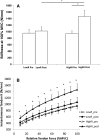Influence of exercise intensity on training-induced tendon mechanical properties changes in older individuals
- PMID: 24760611
- PMCID: PMC4082599
- DOI: 10.1007/s11357-014-9657-9
Influence of exercise intensity on training-induced tendon mechanical properties changes in older individuals
Abstract
This study compared the effects of low vs. high intensity training on tendon properties in an elderly population. Participants were pair-matched (gender, habitual physical activity, anthropometrics, and baseline knee extension strength) and then randomly assigned to low (LowR, i.e., ~40 % 1RM) or high (High R, i.e., ~80 % 1RM) intensity resistance training programmes for 12 weeks, 3× per week (LowR, n = 9, age 74 ± 5 years; HighR, n = 8, age 68 ± 6 years). Patellar tendon properties (stiffness [K], Young's modulus [YM], cross-sectional area [T CSA], and tendon length [T L]) were measured pre and post training using a combination of magnetic resonance imaging (MRI), B-mode ultrasonography, dynamometry, electromyography and ramped isometric knee extensions. With training K showed no significant change in the LowR group while it incremented by 57.7 % in the HighR group (p < 0.05). The 51.1 % group difference was significant (p < 0.05). These differences were still apparent when the data was normalized for T CSA and T L, i.e., significant increase in YM post-intervention in HighR (p < 0.05), but no change in LowR. These findings suggest that when prescribing exercise for a mixed genders elderly population, exercise intensities of ≤40 % 1RM may not be sufficient to affect tendon properties.
Figures


Similar articles
-
Influence of exercise intensity in older persons with unchanged habitual nutritional intake: skeletal muscle and endocrine adaptations.Age (Dordr). 2010 Jun;32(2):139-53. doi: 10.1007/s11357-010-9141-0. Epub 2010 Apr 21. Age (Dordr). 2010. PMID: 20407838 Free PMC article.
-
Patellar tendon adaptation in relation to load-intensity and contraction type.J Biomech. 2013 Jul 26;46(11):1893-9. doi: 10.1016/j.jbiomech.2013.04.022. Epub 2013 Jun 14. J Biomech. 2013. PMID: 23773532 Clinical Trial.
-
Influences of carbohydrate plus amino acid supplementation on differing exercise intensity adaptations in older persons: skeletal muscle and endocrine responses.Age (Dordr). 2010 Jun;32(2):125-38. doi: 10.1007/s11357-009-9129-9. Epub 2010 Jan 29. Age (Dordr). 2010. PMID: 20431985 Free PMC article.
-
Tendon structural and mechanical properties do not differ between genders in a healthy community-dwelling elderly population.J Orthop Res. 2009 Jun;27(6):820-5. doi: 10.1002/jor.20811. J Orthop Res. 2009. PMID: 19058184
-
Human tendon adaptation in response to mechanical loading: a systematic review and meta-analysis of exercise intervention studies on healthy adults.Sports Med Open. 2015 Dec;1(1):7. doi: 10.1186/s40798-015-0009-9. Epub 2015 Mar 27. Sports Med Open. 2015. PMID: 27747846 Free PMC article. Review.
Cited by
-
Patellar tendon length during knee flexion of meniscal-bearing and rotating total knee arthroplasty implants.Knee Surg Sports Traumatol Arthrosc. 2017 Dec;25(12):3773-3778. doi: 10.1007/s00167-016-4279-7. Epub 2016 Aug 12. Knee Surg Sports Traumatol Arthrosc. 2017. PMID: 27517459 Clinical Trial.
-
The Relationship Among Probable SARCopenia, Osteoporosis and SuprasPinatus Tendon Tears in Postmenopausal Women: The SARCOSP Study.Calcif Tissue Int. 2024 Apr;114(4):340-347. doi: 10.1007/s00223-024-01183-7. Epub 2024 Feb 12. Calcif Tissue Int. 2024. PMID: 38342790 Free PMC article.
-
Minimizing sedentary behavior (without increasing medium-to-vigorous exercise) associated functional improvement in older women is somewhat dependent on a measurable increase in muscle size.Aging (Albany NY). 2020 Dec 3;12(23):24081-24100. doi: 10.18632/aging.202265. Epub 2020 Dec 3. Aging (Albany NY). 2020. PMID: 33276345 Free PMC article. Clinical Trial.
-
An 8-week resistance training protocol is effective in adapting quadriceps but not patellar tendon shear modulus measured by Shear Wave Elastography.PLoS One. 2019 Apr 16;14(4):e0205782. doi: 10.1371/journal.pone.0205782. eCollection 2019. PLoS One. 2019. PMID: 30990803 Free PMC article. Clinical Trial.
-
Muscle and tendon adaptations to moderate load eccentric vs. concentric resistance exercise in young and older males.Geroscience. 2021 Aug;43(4):1567-1584. doi: 10.1007/s11357-021-00396-0. Epub 2021 Jul 1. Geroscience. 2021. PMID: 34196903 Free PMC article. Clinical Trial.
References
-
- Bunn F, Dickinson A, Barnett-Page E, McInnes E, Horton K. A systematic review of older people’s perceptions of facilitators and barriers to participation in falls-prevention interventions. Ageing Soc. 2008;28:449–472. doi: 10.1017/S0144686X07006861. - DOI
-
- Burd NA, West DW, Staples AW, Atherton PJ, Baker JM, Moore DR, Holwerda AM, Parise G, Rennie MJ, Baker SK, Phillips SM. Low-load high volume resistance exercise stimulates muscle protein synthesis more than high-load low volume resistance exercise in young men. PLoS One. 2010;5(8):e12033. doi: 10.1371/journal.pone.0012033. - DOI - PMC - PubMed
MeSH terms
Grants and funding
LinkOut - more resources
Full Text Sources
Other Literature Sources
Medical
